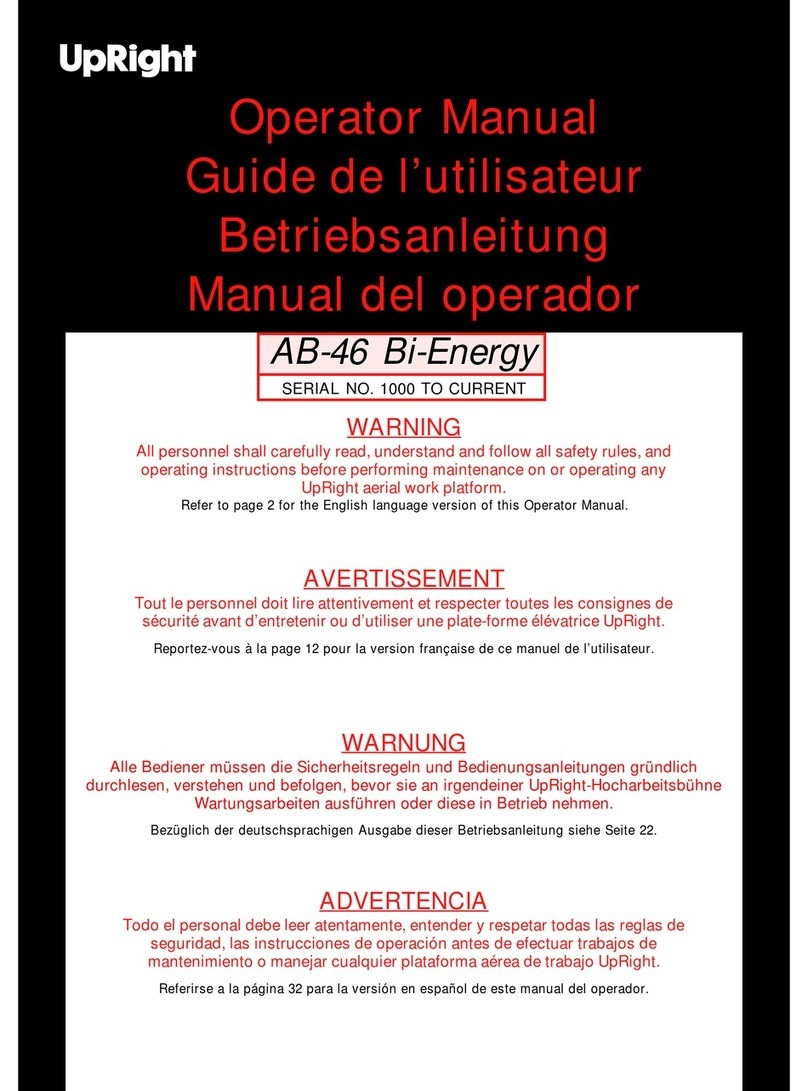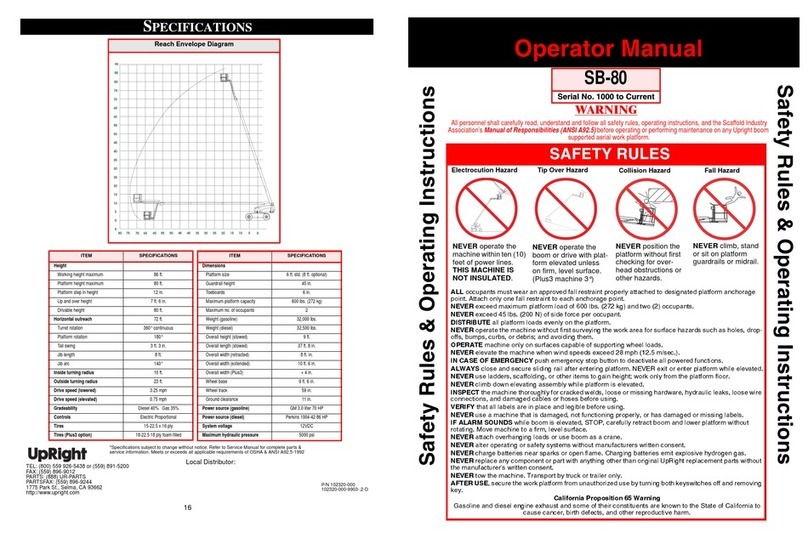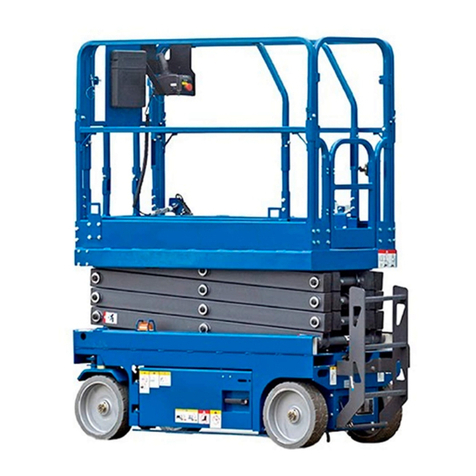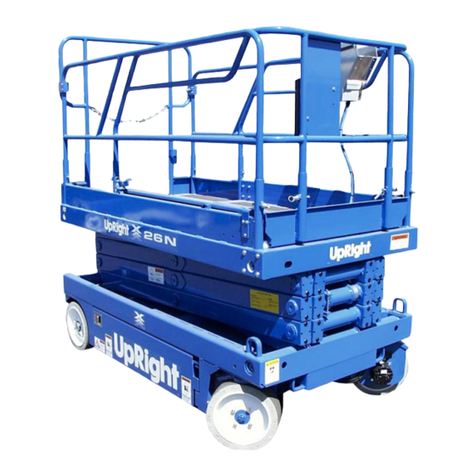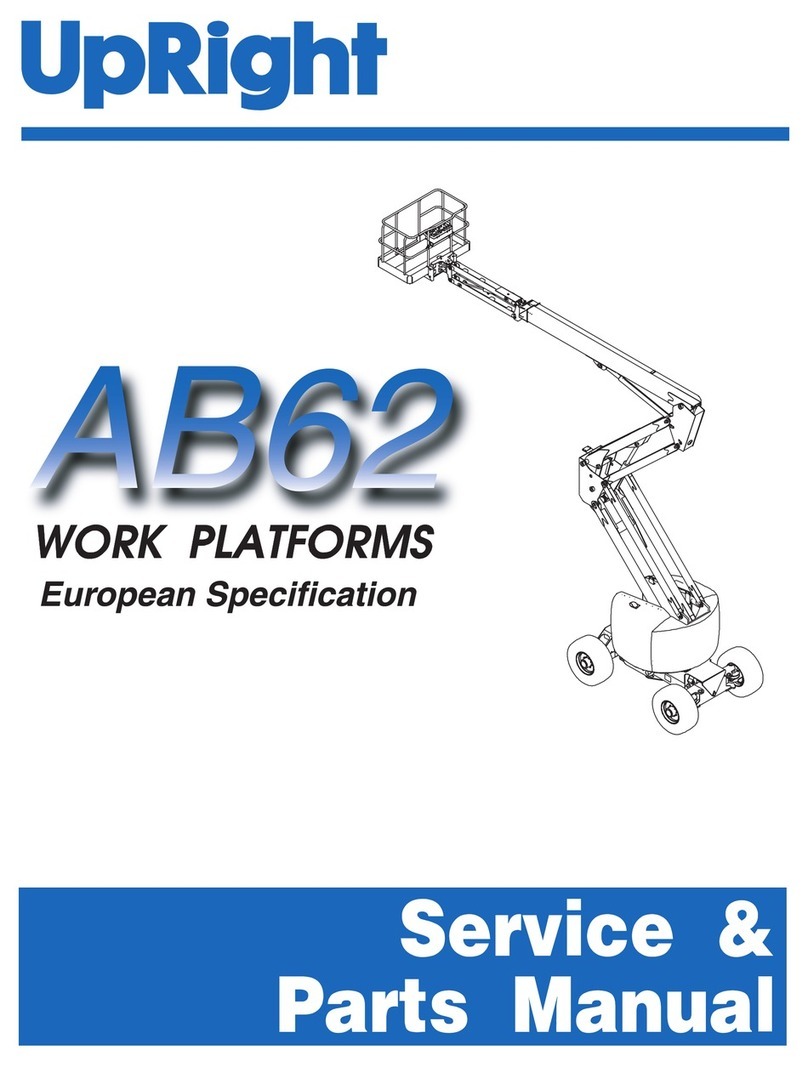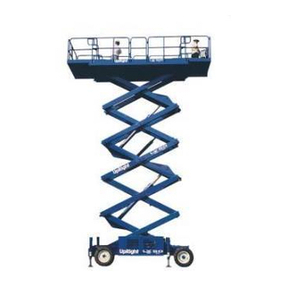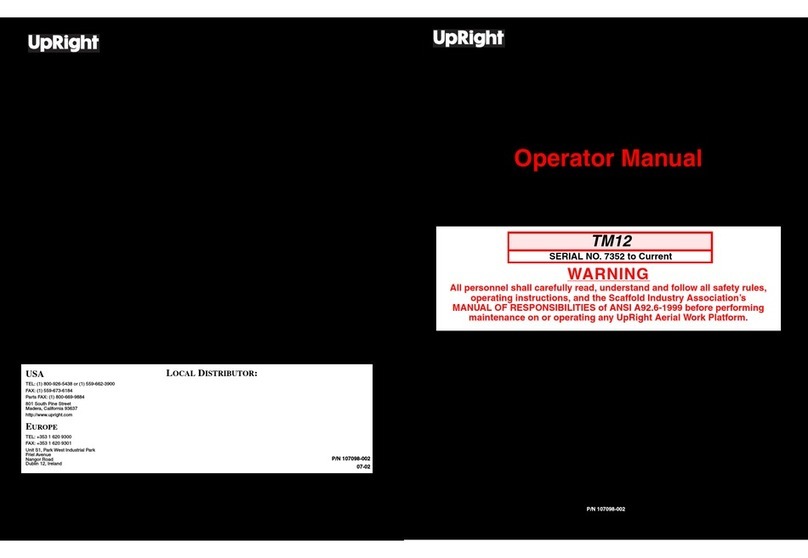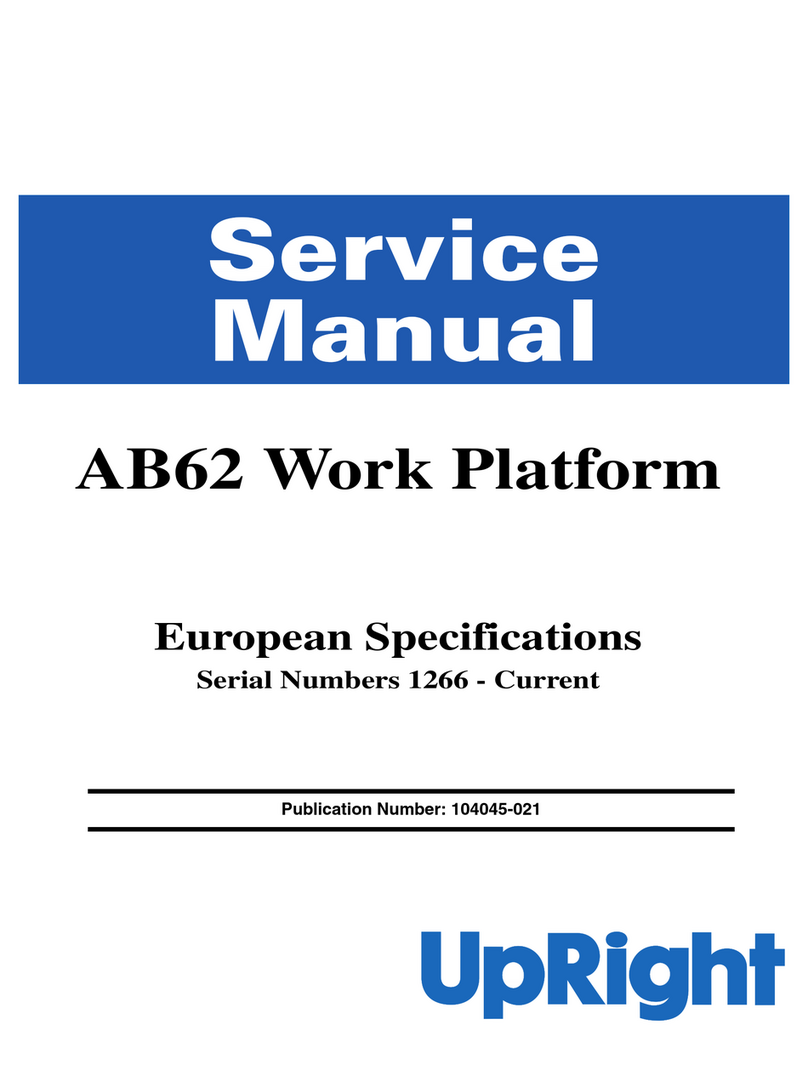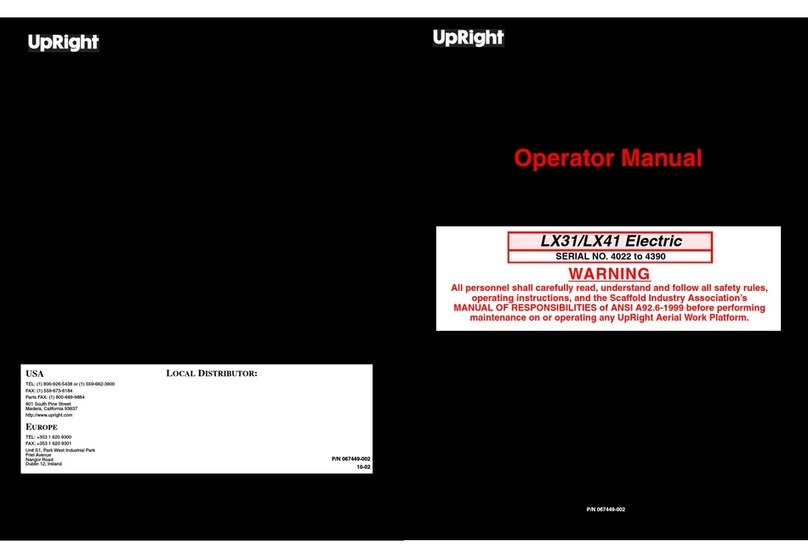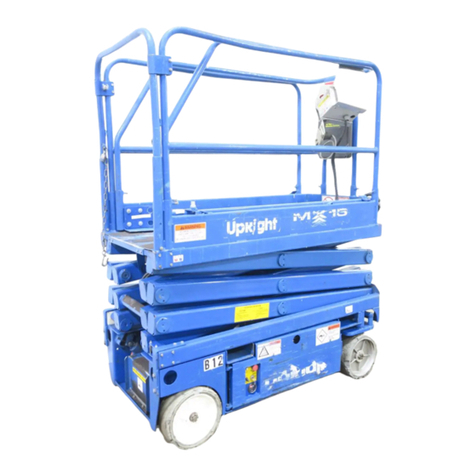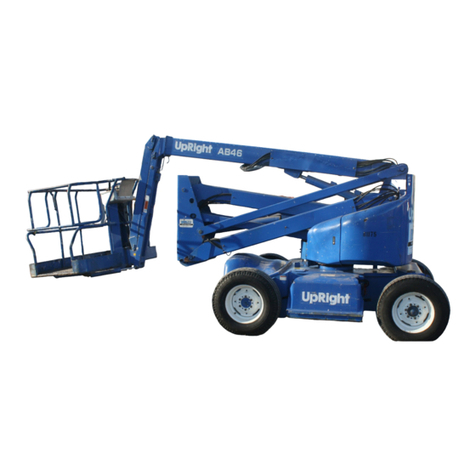6
Battery Maintenance
Hazard of explosive gas mixture. Keep
sparks, flame and smoking materials away
from batteries.
Always wear safety glasses when working
with batteries.
Battery fluid is highly corrosive. Rinse
away any spilled fluid thoroughly with clean
water.
Always replace batteries with UpRight
batteries or manufacturer approved
replacements weighing at least 62 lbs. 28
kg) each.
Check battery fluid level daily, especially if work
platform is being used in a warm, dry climate.
If electrolyte level is lower than 3/8 in. 10 mm)
above plates add distilled water only. DO NOT
use tap water with high mineral content it will
shorten battery life.
Keep terminals and tops of batteries clean.
Refer to the Service Manual to extend battery life
and for complete service instructions.
Battery Charging
Charge batteries at end of each work shift or
sooner if batteries have been discharged.
Charge batteries in a well ventilated area.
Do not charge batteries when the work
platform is in an area containing sparks or
flames.
Permanent damage to batteries will result if
batteries are not immediately recharged
after discharging.
Never leave charger operating unattended
for more than two days.
Never disconnect cables from batteries
when charger is operating.
Keep charger dry.
1. Check battery fluid level. If electrolyte level is
lower than 3/8 in. 10 mm) above plates add
distilled water only.
2. Connect extension cord to charger outlet plug
in Left Chassis Door. Connect extension cord
12 gauge 1.5 mm²) conductor minimum and
50 ft. 15 m) in length maximum) to properly
grounded outlet of proper voltage and fre-
quency.
3. Charger turns on automatically after a short
delay, the LED charge indicator will illuminate.
4. Charger turns off automatically when batteries
are fully charged, the LED charge indicator will
blink.
Green LED
Indicator
Figure 7: Chassis Module, Left Side
Charger Outlet Plug
3
Operation
Before operating work platform ensure that pre-
operation and safety inspection has been completed,
any deficiencies have been corrected and the
operator has been thoroughly trained on this ma-
chine.
Travel With Platform Lowered
1. Check that route is clear of people, obstruc-
tions, holes and drop-offs, is level and is
capable of supporting wheel loads.
2. Verify Chassis Key Switch is turned to DECK
and Chassis Emergency Stop Switch is ON,
pull button out.
3. After mounting platform lower top rail across
entrance and check that gate is closed and
locked. Check that guardrails are properly
assembled and in position with the Slide out
Deck Extension secured with the pin.
4. Check clearances above, below and to the
sides of platform.
5. Pull Controller Emergency Stop Button out to ON
position. When button is pushed down Emer-
gency Stop Switch will automatically go to OFF
position.
6. Turn Key Switch to ON.
7. Position Drive/Lift Switch to DRIVE.
8. While depressing the Interlock Lever, slowly
push or pull the Control Lever to FORWARD or
REVERSE position to travel in the desired
direction. The farther you push or pull the
Control Lever from center the faster the ma-
chine will travel.
Steering
1. With Key Switch ON, position Drive/Lift Switch
to DRIVE.
2. While depressing the Interlock Lever, push the
Steering Switch to RIGHT or LEFT to turn wheels
in the desired direction. Observe the tires while
maneuvering the work platform to ensure proper
direction.
Figure 3: Emergency Lowering Valve Knob
NOTE: Steering is not self-centering. Wheels
must be returned to straight ahead osition by
o erating Steering Switch.
Elevating Platform
1. With the Key Switch ON, position Drive/Lift
Switch to LIFT.
2. While depressing the Interlock Lever, push
Control Lever forward to UP, the farther you push
the Control Lever the faster the Platform will elevate.
3. If the machine is not level the Tilt Alarm will
sound and the machine will not lift or drive. If
the Tilt alarm sounds the latform must be
lowered and the machine moved to a level
location before attem ting to re-elevate the
Platform.
Travel With Platform Elevated
NOTE: Work latform will travel at reduced
s eed when latform is elevated.
1. Check that route is clear of persons, obstruc-
tions, holes and drop-offs, is level and capable
of supporting the wheel loads.
2. Check clearances above, below and to the
sides of platform.
3. With the Key Switch ON, position Drive/Lift
Switch to DRIVE position.
4. While depressing the Interlock Lever, push
Control Lever to FORWARD or REVERSE for
desired direction of travel.
5. If the machine is not level the Tilt Alarm will
sound and the machine will not lift or drive. If
the Tilt Alarm sounds the Platform must be
lowered and the machine moved to a level
location before attem ting to re-elevate the
Platform.
Lowering Platform
1. Position Drive/Lift Switch to LIFT.
2. While depressing the Interlock Lever, pull back
on the Control Lever.
3. The machine will now descend to a predeter-
mined height which will allow you to exit the
Platform safely. While the machine is descend-
ing the audible descent alarm will sound.
4. To lower the Platform fully the following proce-
dure must be followed:
A. Turn Key Switch on Controller to OFF
position and remove key.
B. Insert key into Chassis Key Switch.
C. Visually check elevating assembly to
ensure that no one is in contact with the
machine.
D. Pull the Emergency Lowering Knob and


